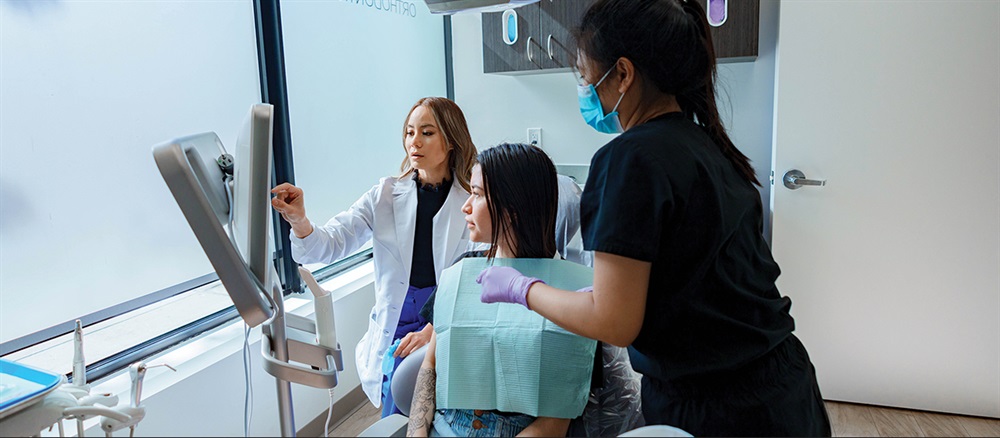In the past few decades, the field of dentistry has witnessed a remarkable transformation driven by technological innovations. Traditional dental practices have evolved significantly, embracing cutting-edge technologies to enhance patient care, diagnosis, and treatment outcomes. From digital dentistry to bioprinting, a myriad of advancements are shaping the future of oral care. If you’re searching for top-notch dental care in Vermont, look no further than Vermont Family Dentistry.
Digital Dentistry: Revolutionizing Dental Practices
Digital dentistry has revolutionized traditional dental practices by incorporating advanced technologies for enhanced precision and efficiency. One of the key components of digital dentistry is digital imaging technology, which enables dentists to capture detailed images of the oral cavity for accurate diagnosis and treatment planning. Additionally, computer-aided design and manufacturing (CAD/CAM) have streamlined the fabrication of dental restorations such as crowns, bridges, and veneers, reducing turnaround time and improving overall quality.
3D Printing in Dentistry: Building the Future of Oral Care
3D printing technology has emerged as a game-changer in dentistry, offering unprecedented customization and precision in the fabrication of dental prosthetics and implants. Dentists can now design and produce patient-specific dental implants and prosthetics with unparalleled accuracy, leading to better functional and aesthetic outcomes. Moreover, 3D printing enables the creation of intricate dental models and surgical guides, facilitating complex dental procedures with ease.
Tele-dentistry: Breaking Geographic Barriers
Tele-dentistry has emerged as a viable solution to overcome geographical barriers and improve access to dental care, particularly in underserved areas. By leveraging telecommunication technologies, dentists can remotely diagnose dental issues, provide consultation, and even conduct follow-up appointments, eliminating the need for patients to travel long distances for dental care. While tele-dentistry offers numerous benefits, including increased convenience and accessibility, challenges such as ensuring patient privacy and establishing reliable communication channels need to be addressed.
Artificial Intelligence (AI) in Dentistry: Enhancing Diagnostic Accuracy
Artificial intelligence (AI) has revolutionized dental diagnostics by analyzing vast amounts of patient data to detect patterns and predict outcomes with remarkable accuracy. AI-powered algorithms can assist dentists in diagnosing dental conditions such as cavities, gum disease, and oral cancer at an early stage, leading to timely interventions and improved treatment outcomes. Furthermore, AI-driven predictive analytics enable personalized preventive care recommendations based on individual risk factors, promoting long-term oral health.
Nanotechnology in Dentistry: Miniaturizing Dental Treatments
Nanotechnology holds tremendous potential in dentistry for miniaturizing dental treatments and improving therapeutic outcomes. Nanomaterials such as nano-hydroxyapatite and nanocomposites exhibit enhanced mechanical properties and bioactivity, making them ideal candidates for dental restorations and repairs. Additionally, nanotechnology enables targeted drug delivery systems for treating oral infections and regenerating damaged tissues, paving the way for minimally invasive and patient-friendly dental therapies.
Virtual Reality (VR) in Dental Education and Therapy
Virtual reality (VR) technology is revolutionizing dental education and therapy by providing immersive and interactive experiences for both dental students and patients. VR simulations offer a realistic environment for dental training, allowing students to practice various dental procedures in a risk-free virtual setting. Moreover, VR distraction therapy has proven to be effective in reducing dental anxiety and fear in patients, enabling them to undergo dental treatments with greater comfort and relaxation.
Bioprinting Teeth: A Glimpse into the Future
Bioprinting technology holds immense promise for the future of dentistry by enabling the fabrication of bioengineered dental tissues and organs. Researchers are exploring bioprinting techniques to create functional tooth structures using biocompatible materials and patient-derived cells, offering a revolutionary approach to tooth replacement and regeneration. While bioprinting teeth is still in the experimental stage, ongoing advancements in tissue engineering and regenerative medicine hold the potential to transform the landscape of dental care in the years to come.
Robotics in Dentistry: Precision and Automation
Robotics is poised to revolutionize dental surgeries by enhancing precision, efficiency, and safety in complex procedures. Robotic-assisted systems enable dentists to perform highly precise dental surgeries with minimal invasiveness, reducing the risk of complications and improving patient outcomes. Additionally, robotic automation streamlines repetitive tasks in dental laboratories, such as milling and polishing dental restorations, thereby increasing productivity and reducing production costs.
IoT Devices in Oral Health Monitoring
Internet of Things (IoT) devices are revolutionizing oral health monitoring by providing real-time data on various oral health parameters, such as brushing habits, plaque buildup, and gum health. IoT-enabled toothbrushes equipped with sensors and connectivity features enable users to track their oral hygiene routines and receive personalized feedback for improving oral health outcomes. Furthermore, IoT devices facilitate remote monitoring by dentists, allowing for proactive interventions and personalized treatment plans based on individual oral health data.
Augmented Reality (AR) in Dental Practice
Augmented reality (AR) technology is transforming the landscape of dental practice by enhancing treatment planning and patient education. AR applications enable dentists to overlay digital images of dental anatomy onto the patient’s oral cavity in real-time, providing a comprehensive visualization of dental conditions and treatment options. Moreover, AR visualization enhances patient engagement and understanding by allowing them to visualize the anticipated outcomes of dental procedures, leading to informed decision-making and improved treatment satisfaction.
Blockchain Technology: Securing Dental Records
Blockchain technology offers a secure and decentralized platform for managing dental records, ensuring the integrity, privacy, and accessibility of patient data. By leveraging blockchain-based systems, dental practices can securely store and share patient records, treatment histories, and diagnostic images across multiple stakeholders while maintaining patient confidentiality and compliance with data protection regulations. Additionally, blockchain enhances transparency and trust in dental transactions, enabling seamless collaboration among dentists, patients, and other healthcare providers.
Smart Toothbrushes and Oral Hygiene Tracking Apps
Smart toothbrushes equipped with advanced sensors and connectivity features are revolutionizing oral hygiene maintenance by providing real-time feedback and personalized coaching to users. These smart devices monitor brushing technique, frequency, and duration, enabling users to optimize their oral hygiene routines for better plaque removal and gum health. Furthermore, oral hygiene tracking apps complement smart toothbrushes by offering comprehensive data analytics and personalized recommendations for improving oral health outcomes, empowering users to take proactive control of their oral hygiene habits.
Gene Therapy in Dentistry: Personalized Oral Care
Gene therapy holds immense promise for personalized oral care by targeting underlying genetic factors contributing to dental diseases and disorders. By delivering therapeutic genes directly to the affected tissues, gene therapy has the potential to correct genetic mutations, stimulate tissue regeneration, and modulate immune responses for improved oral health outcomes. Moreover, gene-based interventions offer a targeted and minimally invasive approach to treating dental conditions, with the potential for long-lasting therapeutic benefits and reduced reliance on conventional treatments such as surgery and medications.
Conclusion
The future of dentistry is defined by a convergence of innovative technologies that are revolutionizing every aspect of oral care, from diagnosis and treatment to patient education and preventive interventions. Digital dentistry, 3D printing, tele-dentistry, AI, nanotechnology, VR, bioprinting, robotics, IoT, AR, blockchain, smart devices, and gene therapy are reshaping the dental industry landscape, offering unprecedented opportunities for personalized, efficient, and patient-centered dental care. As these technologies continue to advance and integrate, dentists and patients alike can look forward to a future where oral health outcomes are optimized, treatments are tailored to individual needs, and dental experiences are transformed for the better.



